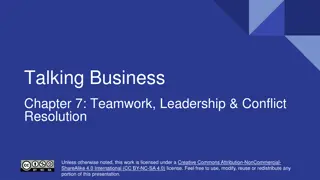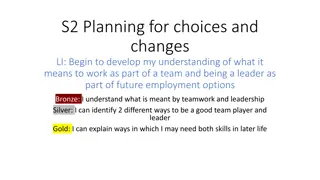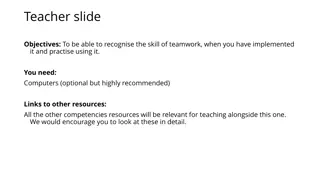Collaborating with Diverse Viewpoints - Enhancing Teamwork and Leadership
Explore the significance of collaboration in leadership, fostering diversity in teams, and respecting varied viewpoints for optimal team performance. Reflect on past sessions, engage in breakout activities, and learn to navigate challenging conversations effectively.
Download Presentation

Please find below an Image/Link to download the presentation.
The content on the website is provided AS IS for your information and personal use only. It may not be sold, licensed, or shared on other websites without obtaining consent from the author.If you encounter any issues during the download, it is possible that the publisher has removed the file from their server.
You are allowed to download the files provided on this website for personal or commercial use, subject to the condition that they are used lawfully. All files are the property of their respective owners.
The content on the website is provided AS IS for your information and personal use only. It may not be sold, licensed, or shared on other websites without obtaining consent from the author.
E N D
Presentation Transcript
RVGS Summer Leadership RVGS Summer Leadership Institute Institute Session 5 June 16 Collaborating with Diverse Viewpoints Please remind Mr. Levy to hit record if he forgets!
Todays Topic: Today s Topic: Collaborating with Diverse Collaborating with Diverse Viewpoints Viewpoints Major topics for today Discussion of Reflection Activity from Monday Review of prior non-guest speaker session The importance of collaboration Leadership that encourages collaboration Diversity in teams Authentically respecting diversity of your team members
Breakout 1: Reflection Activity from Monday Breakout 1: Reflection Activity from Monday Too often, people don t consider the best ways to collaborate with team members to brainstorm new ideas and just lump that in as that part of the decision-making process. While that can be part of the early stages of decision-making, communication and collaboration can be stifled without proper focus on optimal methods to encourage quality teamwork. Interview of adult, asking about a time at work where a decision needed to be made in a meeting or team setting. Did you feel welcome to share your ideas during the discussion? Do you think all team members shared ideas freely? If the previous answers aren t the same, why do you think that was? Did people become connected to their favorite ideas? Did tension arise anywhere in the process? If they didn t lead the meeting, what do they think leader have done to promote increased collaboration? If they were the leader, is there anything they wish they had done differently to encourage collaboration/what worked well? Your team leader will be whoever has been a team leader the least number of times so far break ties with who ate breakfast the earliest this morning.
Review of Last Non Review of Last Non- -Guest Speaker Session Guest Speaker Session Interacting with People Communication norms in a group Seeking to understand and be understood Showing respect as a leader Aligning interests Considering your audience Handling difficult conversations
The Importance of Collaboration The Importance of Collaboration Sometimes leaders underestimate the importance of collaboration, thinking the really important progress for the organization springs from them. Sounds arrogant, but it s easy to get into that frame of mind Statistically speaking, you are likely not the smartest, most informed, or most skilled person in an organization [first two are NOT the same thing]. Even if you were, you can t do it all by yourself.
Do you think that Phil Jackson is saying You know, Kobe, we d be doing a lot better if I was taking your shots for you ? I m guessing not Coaches don t score any points they work to put others in a good position to do so CEOs don t make any sales they work to put others in a good position to do so Mayors don t build roads they work to put others in a good position to do so I could keep going, but you get the idea
Breakout 2: What is the difference between Breakout 2: What is the difference between collaboration and people just doing their jobs? collaboration and people just doing their jobs? The team leader will be whoever has been TL the least times, tie- breaker the person who is least interested in basketball and didn t get the point of the Phil Jackson/Kobe Bryant picture. On the last slide I said coaches don t score points and CEOs don t make sales. That doesn t necessarily mean that collaboration is going on. Discuss the difference between collaboration and people doing what they are told . The TL will pick one or two short summary comments to post to the chat for the larger group. Think about how you will figure out the best way to summarize the discussion or if you are even the one who should be summarizing.
Breakout 2 Summary: What is the difference between Breakout 2 Summary: What is the difference between collaboration and people just doing their jobs? collaboration and people just doing their jobs? Team Leaders please post your summary comments in the chat. Everyone take a moment to read what the other teams discussed. Recall our first session we said that people have the need to be important. Simply giving them tasks doesn t satisfy that instead give them ownership and empower them. This will be motivating and they will aspire to do their best.
Leadership that Encourages Collaboration Leadership that Encourages Collaboration Classic mistake of someone who never allowed input after receiving the previous advice: I asked everyone what they thought and gave them a chance to contribute to the plan, but they just looked at me. This confirms that I just need to do what I normally do. Recall our discussion during Session 1 about authenticity and consistency. Everything you do as a leader draws from the foundation you have build. You have to build a culture where people are comfortable being contributors instead of worker bees.
Building a Collaborative Culture Building a Collaborative Culture This stuff is mostly common sense (but doesn t mean it s common): Consistently give people the opportunity to provide input, individually and in a group setting Encourage people to release ideas to the group instead owning them Ask productive questions ( What could go wrong with this? ) Invite feedback from individuals you aren t hearing from (ex.) Don t show favoritism toward some people in the group Recognize individual talents and contributions Avoid being territorial about your own ideas. Don t ask for input if you won t use it sometimes the leader needs to act unilaterally point it out when it happens. Encourage productive disagreement; devil s advocate can be good
Breakout 3 Breakout 3 Team leader will be whoever has been team leader the least, break ties with whoever has the most letters in their last name. In your group, discuss how you could encourage someone to collaborate you one on one as you are delegating a task. Then discuss what you could do to promote healthy collaboration between two people who have been assigned to work together on something. The team leader will post one response to each in the chat after the breakout.
Breakout 3 Review Breakout 3 Review Team leaders, post the comment about one on one collaboration in a chat that starts as 1on1- blah blah Post the comment about helping a team of two collaborate in a chat starting with Team- blah blah
Diversity in Teams Diversity in Teams Diversity in a discussion or decision-making progress is a source of strength for the organization. Without diversity, everyone in the group tends to think the same, which yields limited options for problem- solving. Aside from the types of diversity you may be thinking of, don t ignore differences in experience, role/department, prospective, and formal power structure. Having a diverse group doesn t help if people don t feel welcome and willing to contribute.
Preferred Culture in Low Diversity Groups Preferred Culture in Low Diversity Groups Within low diversity groups, the preferred culture of the group is based on the composition. Some soft examples: In a cub scout meeting, everyone is expected to act like a kid and no one is going to be disrespected or feel uncomfortable when they do In a Senate hearing, everyone is expected to act in accordance with certain expectations. Playing by those rules normally results in being treated with respect People who don t align with the composition of a low diversity group could be subject to disrespect and discomfort Imagine how one of those Senators would feel (and be regarded) at a rodeo or rap concert.
Preferred Culture in Mixed or Public Groups Preferred Culture in Mixed or Public Groups In groups with more diversity or in a public setting (such as work, school, government, etc), the cultural preference tends to align with a dominant culture for that society. Consider the Senator at the rodeo. Attendees might belittle him there, but in mixed or public settings the opposite is more likely to be true.
The sad truth of current society in the US The sad truth of current society in the US Some people become uncomfortable with these types of discussions that can hold us back in addressing these issues. Frankly speaking, the dominant culture in the U.S. is racist, sexist, and elitist, with a preference toward individuals who are white, male, heterosexual, cis- gender, wealthy, educated, able-bodied, and in positions of authority.
Attitudes of the Culture vs the Individual Attitudes of the Culture vs the Individual It can be helpful to distinguish systematic bias vs personal prejudice. Individuals may claim not to be personally racist, sexist, etc, but everyone has some prejudices they need to be internally honest about. Regardless of how woke an individual thinks they are, they are still part of a system biased for favored groups. Example: to say society is racist means there is a systematic bias that gives whites built-in advantages and minorities built-in disadvantages. It doesn t mean that white people don t have difficulties just that their race is not an additional source of difficulty. It doesn t mean racial minorities can t be successful - but their success comes in the context of unjust disadvantages If you are saying maybe some people but not me honestly, you are being na ve. Let me give a personal example.
Passing in the Dominant Culture Passing in the Dominant Culture People can increase how well they pass in the dominant culture by de-emphasizing ways in which they diverge from cultural preferences. They might modify their speaking style, physical appearance, demeanor, their name, etc. There is pressure to pass to make life easier for people from discriminated groups when in dominant culture spaces like workplace, banks, public institutions, etc. While these might seem like willing choices or even personal preferences, it is often a strategy avoid injustice or to even the playing field. Just because someone says something doesn t bother them doesn t mean it that s the case.
Authentically Respecting Diversity as a Leader Authentically Respecting Diversity as a Leader Your actions as a leader can either re-inforce the dominant culture (applying pressure to pass to successfully be part of the group) or will demonstrate inclusiveness and welcome people to show up as their authentic selves. Hopefully I don t need to point out which strategy is right. This is a series on leadership, not culture. A full discussion of these topics is not within our scope, but I encourage you to seek out additionally reading and resources on these topics.
This weeks reflection activity This week s reflection activity Consider areas of your own privilege. Review this list and identify whether or not you are aligned with the favored group for each category: race, gender/gender identity, sexuality, household income, family educational level, religion, ability/disability/health Reflect on situations in which each of those categories could prevent feeling welcome to contribute during a meeting at work or through a public organization. Consider ways, subtle or overt, that people could undermine the standing of someone not in the favored group for each of the categories. Consider instances when the person is physically present and when they are not. If you are part of the favored group, dig deeper than your superficial assumptions about what people face. If you haven t been concerned about wearing your hair naturally for a job interview, been told that your mood is just a result of your hormones, or had someone hesitate to share a bathroom/locker room with you then you won t be able to understand other people s experiences without actual effort, conversation, and research. Recognizing the leader cannot regulate all interactions, brainstorm ways in which you could promote an inclusive culture that sends the right messages about your expectations for how peers should be treated in an organization.























